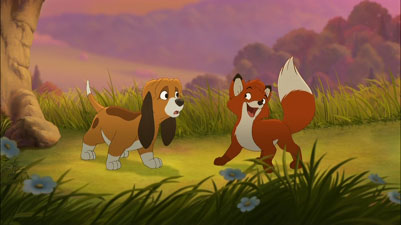The Fox and the Hound 2
Directed by Jim Kammerud
Written by Roger S.H. Schulman and Rich Burns
Starring Reba McEntire, Patrick Swayze, Jeff Foxworthy
There are a few sure ways to get me uninvolved in a story, and prequels are at the top of the list. Considering how prevalent prequels are in our culture these days, it’s worth clarifying why they almost always do nothing for me. I’m sure, for example, I’ll go into more detail on this topic when we discuss Monsters University on the podcast next summer, but now’s just as good a time to get into it. What prequels do chiefly is eliminate tension. For this discussion, we can extend that into midquels, a shudder-worthy term referring to stories that take place within the larger timeline of its predecessor. Whether it’s a prequel or a midquel, such a story features as little tension as possible from the moment of its conception.
Think about it. Prequels and midquels exist with the knowledge that the audience has likely seen the original stories. There are, perhaps, occasions when a person will watch the prequel or midquel to a preexisting series, but the filmmakers are arguably not targeting their work to that person. They want the people who love the preexisting series to attend the prequel or midquel in droves. So the audience, by and large, knows where the story is going. We know that Anakin Skywalker will one day transform into Darth Vader. We know that he may be a happy kid now, but he’ll one day be donning a black mask and breathing apparatus. The only question is how and why that happens. But it does happen. We know going into the theater, let alone during the movie, where the story has to end so it can lead into the stories we’ve seen already.
Midquels are even more challenging to make compelling, which is why they’re not nearly as familiar as prequels. When a group of people tell one story, and then another group endeavors to tell a story within the first one, the stakes are raised. How do you make the second story, the one happening during the first one, compelling? Even more than with a prequel, the audience knows the midquel can only do so much. They’re mostly not common outside of the world of Disney direct-to-DVD films (though there are a few video games that are midquels, as well as one of the eighteen billion Saw movies), which is truly baffling. The Disney direct-to-DVD sequels are best typified by seeming lazy—whether you’ve seen them or not, this is the prevailing opinion. So why would movies that are considered lazy then attempt to be the exact opposite?
The cynical answer is “to make money.” While the more idealistic answer would be “A good story should be told, no matter what,” I fear that the people behind The Fox and the Hound 2 weren’t that interested in telling a good story, let alone a halfway decent story. For those who may not remember or be aware, this is a midquel to The Fox and the Hound, which tells the story of a fox and a hound who strike up an unlikely friendship as youngsters. That friendship is challenged when they grow up and begin acting more like…well, foxes and hounds. When Tod and Copper (the titular fox and hound, respectively) are younger, their playtime is innocuous, harmless. But Copper’s gruff owner loathes foxes as a whole, and after taking Copper away for a few months on a long hunting trip, the two animals grow up and their friendship is permanently different.
If you’ve been listening to the show for a while, or if you’ve been catching up from the beginning, you know that I’ve discussed The Fox and the Hound on the podcast and wasn’t a great fan. In watching its midquel, I decided to watch both films, back to back. This was a mistake for myriad reasons, about which more soon. What I appreciated a bit more in my rewatch of The Fox and the Hound was the animation, which strives to be very naturalistic a la Bambi. The 1981 film featuring the voices of Mickey Rooney and Kurt Russell strives far too much to be like Bambi, but better to attempt to be like a classic, I suppose. Either way, the animation is far cleaner and more beautiful than the animation Disney created in the 1970s. While there were plenty of production troubles surrounding The Fox and the Hound, and the finished product is far from perfect, its quiet, laid-back tone is fairly impressive.
The events of The Fox and the Hound 2 take place within the first half of The Fox and the Hound, as our lead characters, Tod and Copper, are still kids. They’re also already friends, which means the events occur within about a 30-minute period (and frankly, it might be less than that). An entire story taking place in that small period of time is shaky ground to begin with, mostly because of one unavoidable fact: the characters in the original film will never once acknowledge the events of the midquel. Maybe there are movies or video games or books that have had this happen. (I believe one of the books in the Narnia series functions as a midquel, so maybe C.S. Lewis moved away from this pitfall.) The Fox and the Hound 2 is not a midquel that was ever referenced in the original. And why would it be? The original came out 25 years before the midquel, well before the notion of making direct-to-video or direct-to-DVD sequels became reality.
As such, The Fox and the Hound 2 barely tries to connect to what came before. Yes, we still have Tod and Copper, lovable characters who are friends to the end. Yes, we still have their owners, the friendly Widow Tweed and the gruff Amos Slade. And that’s about it. There’s barely any animosity directed at Tod from Amos Slade or his older dog, Chief. It’s present early on, but it’s also treated as the foundation for goofy humor. What’s more, by the end of the film, Amos, Widow Tweed, Tod, and Copper are all relaxing together happily, which goes against the very idea of the original. Though I’m no fan of The Fox and the Hound, the character relationships all made sense to a degree. Eventually, Amos becomes, if not kinder, less of a jerk. But he only does so after trying to literally smoke out an older Tod and his lady friend Vixey. For the character to be friendly with Widow Tweed and Tod when Tod’s a youngster makes no sense. Why, then, would he react so harshly towards Tod at any point later in the original film?
The answer is, I fear, that the people making the midquel either avoided the original or just chose to ignore it. While I don’t hold The Fox and the Hound as some sacred text, the basic concept presented in the original film should stand within the second film. Instead of trying to tell another full story about our title characters, The Fox and the Hound 2 tries and fails at telling a story around Tod and Copper, one in which they’re somewhat integral but not nearly as much as in the original. The problem, then, lies with the filmmakers in creating compelling new characters who will also—and we know this from the outset—did not feature in any way in the 1981 film. I call it a problem because the filmmakers fail here, too.
Tod and Copper go to a state fair and befriend a group of dogs who sing, and then Copper tries to join the group, and then havoc ensues, because of course it does. A group of singing dogs is where I mentally get tripped up. Why is this something people would want to see? I appreciate that there’s a novelty aspect inherent in the idea, but novelty cannot eliminate the fact that dogs are sweet, cute, and adorable, and they can’t sing worth a damn. Even if the songs in this movie were tuneful and catchy—which they aren’t—the inescapable truth is that dogs singing to humans is strange one way or the other. Down one path, the writers choose to make the dogs sound like dogs, so humans are paying money to listen to dogs howl and bark, which is weird. Down the other, the writers choose to make dogs be able to talk, and make a movie where humans aren’t blown away by this fact. It’s a lose-lose situation.
Disney tried to get some big names to be involved in this new film, including Reba McEntire, Jeff Foxworthy, and the late Patrick Swayze. But so much of this story falls flat because I know it has no bearing on the title characters. Tod and Copper’s friendship is renewed at the end of this movie, after some shaky period where they question each other’s priorities. Is Copper becoming too deliriously addicated with fame? Is Tod being overly selfish in wanting to control his friend? The correct answer to these and other questions is: who cares? Tod and Copper’s friendship, as documented in the first film, has plenty of bumps in the road, but none of them relate to this little state-fair business. Why tell this story?
Yes, I know, the answer is “to make money.” I know that the Disney direct-to-DVD sequels, by and large, do not exist for any creative purpose. I get that. But that doesn’t matter to me in the context of making a podcast. I’m not a shareholder, so I don’t care that Disney made these movies for purely financial reasons. Or, rather, I won’t forgive them for having done so. Sure, they’re a business, but their business is in entertaining people. People pay them money in the hopes of being entertained. They’re either hoping to be entertained themselves, or for their children to be entertained. Even when a mother or a father buys or rents a movie simply to keep the kids occupied for a while—and in this case, it’d be a short while, as the film’s 69 minutes with its end credits—they probably want those kids to be…you know, occupied. That means the kids have to be entertained a bit.
No such luck with The Fox and the Hound 2. I keep hoping, and will continue to do so, that we’ll find a direct-to-DVD sequel that doesn’t blatantly suck, to the point where it seems obvious that the filmmakers didn’t care about delivering a high-quality product. Midquels are a challenge, and one these filmmakers aren’t up to. I appreciate that Disney wanted to make money, but something about the idea of a midquel is so baffling to me. If you’re going to make a movie that essentially exists to make money, why would you want to choose a format that automatically creates storytelling roadblocks? I wish I knew the answer based on The Fox and the Hound 2, but I’m just as stumped as I was before.








